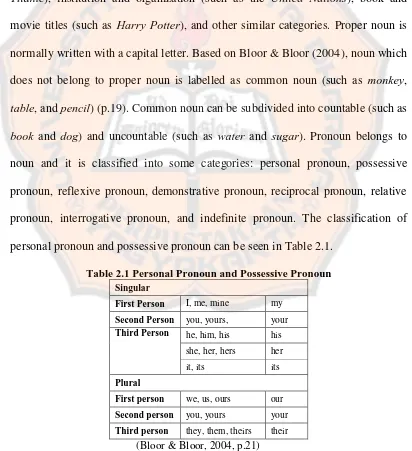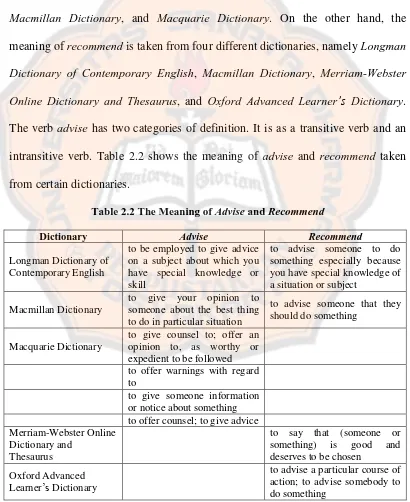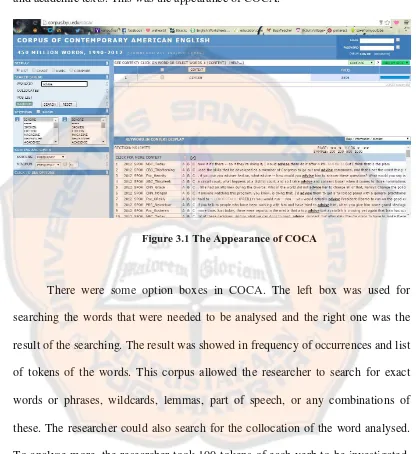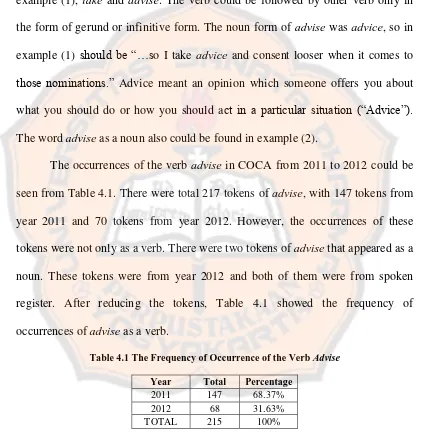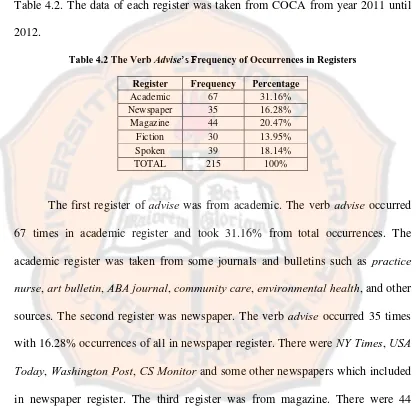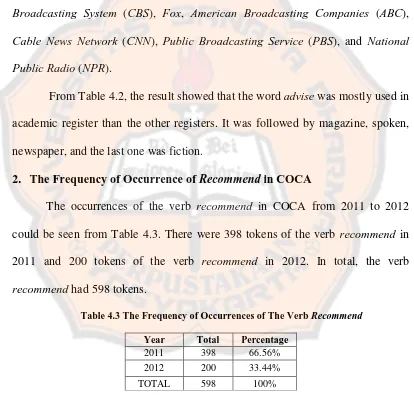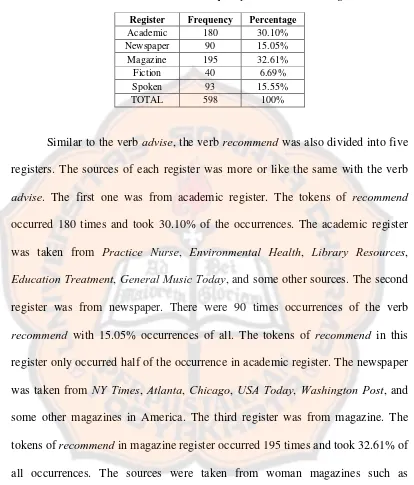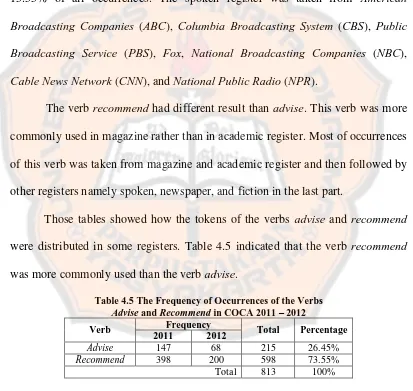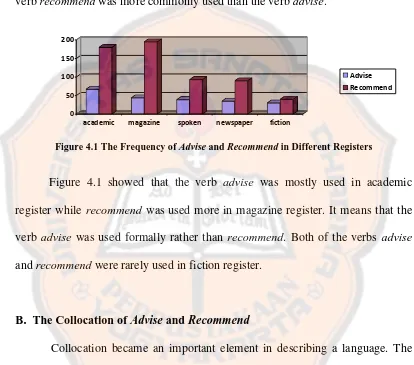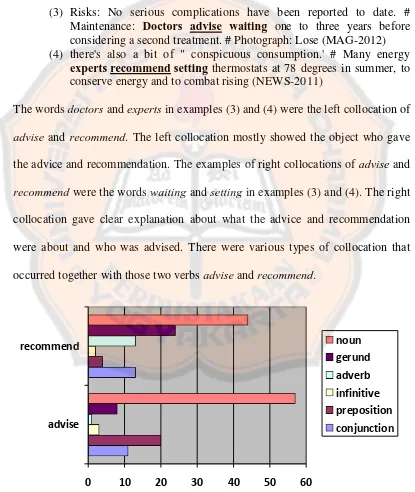vii ABSTRACT
Riski, Disa Ayu Karina. (2015). A Corpus-based Analysis of Frequency and Collocation of the Verbs Advise and Recommend. Yogyakarta: Sanata Dharma University.
Words that share similar senses of meaning are called synonymous. People often give others some ideas to consider or action to do. The words advise and
recommend are synonymous in meaning. However, these words are not exactly interchangeable. They can be used in similar and different contexts. The researcher was interested to study the frequency of occurrences and the collocations of the verbs advise and recommend. The meaning of those words can be analysed by looking at their collocations.
There are two research problems formulated in this study. The first one is 1) What is the frequency of occurrences of the verbs advise and recommend in quantitative research. For the second research problem, the researcher conducted a qualitative research. This was a corpus-based study. The data were collected from COCA using purposive sampling method. The researcher took 100 tokens of each verb which represents the meanings of advise and recommend to be investigated deeper. To solve the first research problem, the researcher employed the theories of corpus linguistic and frequency. To solve the second research problem, the researcher employed the theories of meaning and synonymy. The researcher also used dictionaries to convey the definition of advise and recommend.
The findings showed that the frequency of occurrences of the verb
recommend was higher than advise. In the percentage, the frequency of occurrence of advise was 26.63% and recommend was 73.37%.From the analysis, the researcher discovered that there were some similar collocations of advise and recommend. The collocations of the verb advise and recommend were nouns, gerunds, adverbs, infinitives, prepositions, and conjunctions. There were five similar collocations of the verbs advise and recommend which were that, doctor,
highly, using and against. They both were used to give advice to someone especially because the person had a special knowledge of the situation. They were also used to give opinion or something or someone as worthy to be chosen or to be done. Advise and recommend was also used to offer warnings with regard, which presented by the word against. Unlike the verb recommend, the verb advise
viii sering memberikan orang lain ide untuk dipertimbangkan ataupun kegiatan untuk dilakukan. Kata kerja advise dan recommend mempunyai kemiripan makna. Dalam penggunaannya, kedua kata kerja sinonim ini tidak dapat dipertukarkan secara tepat. Mereka dapat digunakan di konteks yang sama maupun berbeda. Oleh karena itu, peneliti merasa tertarik untuk mempelajari frekuensi kemunculan dan kolokasi dari kedua kata tersebut. Dengan melihat kemunculan kata dan kolokasinya, konteks penggunaan dari kata kerja tersebut dapat diketahui.
Ada dua pertanyaan yang akan dirumuskan dalam penelitian ini. Pertama (1) Apa frekuensi kemunculan dari kata kerja advise dan recommend di Corpusof Contemporary American English (COCA) 2011 - 2012? Kedua (2) Berdasarkan kolokasinya, di konteks apakah kata kerja advise dan recommend mempunyai bersama dan berbeda? Maka dari itu, tujuan dari penelitian ini adalah untuk mengetahui frekuensi kemunculan kata dan kolokasi dari kata kerja advise dan
recommend di COCA 2011 – 2012.
Untuk menjawab rumusan masalah tersebut, peneliti melakukan penelitian kualitatif berdasarkan studi korpus. Data yang diteliti diambil dari COCA menggunakan metode purposive sampling. Peneliti mengambil masing-masing 100 contoh kalimat dari kata kerja advise dan recommend yang dapat merepresentasikan makna kata tersebut untuk diteliti lebih dalam. Untuk menjawab rumusan masalah yang pertama, peneliti menggunakan teori korpus linguistik dan frekuensi. Sedangkan untuk rumusan masalah yang kedua, peneliti menggunakan teori makna dan sinonim. Peneliti juga menggunakan beberapa kamus untuk mengungkapkan definisi dari kata advise dan recommend.
Hasil dari pelitian menunjukkan bahwa frekuensi kemunculan dari kata kerja recommend lebih tinggi daripada advise. Dalam bentuk persentase, frekuensi kemunculan dari kata kerja advise adalah 26.63% dan recommend
adalah 73.37%. Dari analisis tersebut, peneliti menemukan beberapa kesamaan kolokasi dari kata kerja advise dan recommend. Kolokasi kata tersebut dalam bentuk kata benda, gerunds, kata keterangan, infinitif, kata depan, dan kata penghubung. Ada lima kesamaan kolokasi yaitu that, doctor, highly, using, dan against. Kedua kata kerja tersebut digunakan untuk memberikan saran kepada seseorang terutama karena orang yang memberikan saran mempunyai pengetahuan lebih terhadap situasi tertentu. Mereka juga digunakan untuk memberikan opini atau sesuatu atau seseorang yang layak untuk dilakukan atau dipilih. Mereka juga digunakan untuk menawarkan peringatan yang diwakilkan dengan kolokasi against. Tidak seperti recommend, advise dapat digunakan untuk menginformasikan seseorang tentang sesuatu.
OF THE VERBS ADVISE AND RECOMMEND
A SARJANA PENDIDIKAN THESIS
Presented as Partial Fulfillment of the Requirements to Obtain the Sarjana Pendidikan Degree
in English Language Education
By
Disa Ayu Karina Riski Student Number: 101214139
ENGLISH LANGUAGE EDUCATION STUDY PROGRAM DEPARTMENT OF LANGUAGE AND ARTS EDUCATION FACULTY OF TEACHERS TRAINING AND EDUCATION
SANATA DHARMA UNIVERSITY YOGYAKARTA
i
A CORPUS-BASED ANALYSIS OF FREQUENCY
AND COLLOCATION OF THE VERBS
ADVISE AND RECOMMEND
A SARJANA PENDIDIKAN THESIS
Presented as Partial Fulfillment of the Requirements to Obtain the Sarjana Pendidikan Degree
in English Language Education
By
Disa Ayu Karina Riski Student Number: 101214139
ENGLISH LANGUAGE EDUCATION STUDY PROGRAM DEPARTMENT OF LANGUAGE AND ARTS EDUCATION FACULTY OF TEACHERS TRAINING AND EDUCATION
SANATA DHARMA UNIVERSITY YOGYAKARTA
iv
“If what’s ahead scares you and
what’s behind hurts you,
just look above, He never fails to
help you.
”
v
STATEMENT OF WORK’S ORIGINALITY
I honestly declare that this thesis, which I have written, does not contain the work or parts of the work of other people, except those cited in the quotations and the references, as a scientific paper should.
Yogyakarta, 31 July 2015 The writer
vi
LEMBAR PERNYATAAN PERSETUJUAN
PUBLIKASI KARYA ILMIAH UNTUK KEPERLUAN AKADEMIS
Yang bertanda tangan di bawah ini, saya mahasiswa Universitas Sanata Dharma: Nama : Disa Ayu Karina Riski
Nomor Mahasiswa : 101214139
Demi pengembangan ilmu pengetahuan, saya memberikan kepada Perpustakaan Universitas Sanata Dharma karya ilmiah saya yang berjudul:
A CORPUS-BASED ANALYSIS OF FREQUENCY
AND COLLOCATION OF THE VERBS
ADVISE AND RECOMMEND
beserta perangkat yang diperlukan (bila ada). Dengan demikian saya memberikan kepada Perpustakaan Universitas Sanata Dharma hak untuk menyimpan, mengalihkan dalam bentuk lain, mengelolanya dalam bentuk pangkalan data, mendistribusikan secara terbatas, dan mempublikasikannya di internet atau media lain untuk kepentingan akademis tanpa perlu meminta ijin kepada saya atau memberikan royalti kepada saya selama tetap mencantumkan nama saya sebagai penulis.
Demikian pernyataan ini saya buat dengan sebenarnya,
Dibuat di Yogyakarta Pada tanggal: 31 Juli 2015 Yang menyatakan
vii ABSTRACT
Riski, Disa Ayu Karina. (2015). A Corpus-based Analysis of Frequency and Collocation of the Verbs Advise and Recommend. Yogyakarta: Sanata Dharma University.
Words that share similar senses of meaning are called synonymous. People often give others some ideas to consider or action to do. The words advise and
recommend are synonymous in meaning. However, these words are not exactly interchangeable. They can be used in similar and different contexts. The researcher was interested to study the frequency of occurrences and the collocations of the verbs advise and recommend. The meaning of those words can be analysed by looking at their collocations.
There are two research problems formulated in this study. The first one is 1) What is the frequency of occurrences of the verbs advise and recommend in quantitative research. For the second research problem, the researcher conducted a qualitative research. This was a corpus-based study. The data were collected from COCA using purposive sampling method. The researcher took 100 tokens of each verb which represents the meanings of advise and recommend to be investigated deeper. To solve the first research problem, the researcher employed the theories of corpus linguistic and frequency. To solve the second research problem, the researcher employed the theories of meaning and synonymy. The researcher also used dictionaries to convey the definition of advise and recommend.
The findings showed that the frequency of occurrences of the verb
recommend was higher than advise. In the percentage, the frequency of occurrence of advise was 26.63% and recommend was 73.37%.From the analysis, the researcher discovered that there were some similar collocations of advise and recommend. The collocations of the verb advise and recommend were nouns, gerunds, adverbs, infinitives, prepositions, and conjunctions. There were five similar collocations of the verbs advise and recommend which were that, doctor,
highly, using and against. They both were used to give advice to someone especially because the person had a special knowledge of the situation. They were also used to give opinion or something or someone as worthy to be chosen or to be done. Advise and recommend was also used to offer warnings with regard, which presented by the word against. Unlike the verb recommend, the verb advise
viii sering memberikan orang lain ide untuk dipertimbangkan ataupun kegiatan untuk dilakukan. Kata kerja advise dan recommend mempunyai kemiripan makna. Dalam penggunaannya, kedua kata kerja sinonim ini tidak dapat dipertukarkan secara tepat. Mereka dapat digunakan di konteks yang sama maupun berbeda. Oleh karena itu, peneliti merasa tertarik untuk mempelajari frekuensi kemunculan dan kolokasi dari kedua kata tersebut. Dengan melihat kemunculan kata dan kolokasinya, konteks penggunaan dari kata kerja tersebut dapat diketahui.
Ada dua pertanyaan yang akan dirumuskan dalam penelitian ini. Pertama (1) Apa frekuensi kemunculan dari kata kerja advise dan recommend di Corpusof Contemporary American English (COCA) 2011 - 2012? Kedua (2) Berdasarkan kolokasinya, di konteks apakah kata kerja advise dan recommend mempunyai bersama dan berbeda? Maka dari itu, tujuan dari penelitian ini adalah untuk mengetahui frekuensi kemunculan kata dan kolokasi dari kata kerja advise dan
recommend di COCA 2011 – 2012.
Untuk menjawab rumusan masalah tersebut, peneliti melakukan penelitian kualitatif berdasarkan studi korpus. Data yang diteliti diambil dari COCA menggunakan metode purposive sampling. Peneliti mengambil masing-masing 100 contoh kalimat dari kata kerja advise dan recommend yang dapat merepresentasikan makna kata tersebut untuk diteliti lebih dalam. Untuk menjawab rumusan masalah yang pertama, peneliti menggunakan teori korpus linguistik dan frekuensi. Sedangkan untuk rumusan masalah yang kedua, peneliti menggunakan teori makna dan sinonim. Peneliti juga menggunakan beberapa kamus untuk mengungkapkan definisi dari kata advise dan recommend.
Hasil dari pelitian menunjukkan bahwa frekuensi kemunculan dari kata kerja recommend lebih tinggi daripada advise. Dalam bentuk persentase, frekuensi kemunculan dari kata kerja advise adalah 26.63% dan recommend
adalah 73.37%. Dari analisis tersebut, peneliti menemukan beberapa kesamaan kolokasi dari kata kerja advise dan recommend. Kolokasi kata tersebut dalam bentuk kata benda, gerunds, kata keterangan, infinitif, kata depan, dan kata penghubung. Ada lima kesamaan kolokasi yaitu that, doctor, highly, using, dan against. Kedua kata kerja tersebut digunakan untuk memberikan saran kepada seseorang terutama karena orang yang memberikan saran mempunyai pengetahuan lebih terhadap situasi tertentu. Mereka juga digunakan untuk memberikan opini atau sesuatu atau seseorang yang layak untuk dilakukan atau dipilih. Mereka juga digunakan untuk menawarkan peringatan yang diwakilkan dengan kolokasi against. Tidak seperti recommend, advise dapat digunakan untuk menginformasikan seseorang tentang sesuatu.
ix
ACKNOWLEDGEMENTS
I thank all who in one way or another contributed in the completion of this thesis. First, I would like to thank Jesus Christ for His blessing that I can finally finish my thesis.
My deepest gratitude goes to my advisor, Carla Sih Prabandari, S. Pd., M. Hum. for her guidance and assistance during the process, spending time to read, correcting my thesis, and giving attention and suggestion until the final process of writing this thesis patiently. I specially thank my academic advisor, Henny Herawati, M.Hum. for her kindness in accompanying my class during my study. I thank all lecturers of English Language Education Study Program for teaching along the study in Sanata Dharma University. I would also thank all secretariat staff of English Language Education Study Program and Faculty of Teachers Training and Education of Sanata Dharma University and all librarians for giving me their the best service.
I would like to show my deepest gratitude to my family especially my parents, Ignatius Herwan Soewandono and Mustiola Trikindarti, who always give me their love, attention, and time. I thank them for their prayer and financial support. They are my reason and biggest motivation for finishing my study. I would also like to mention Antonius Oldi Bagas for being a great brother.
x
to Diah Dwi Pratiwi and Christiana Anindya, who give corrections and suggestions for my writing. My very special appreciation goes to Amalia Amanda Kasih, Meinadia Sekar Kinanthi, Caesilia “Makibao” Carolina, Ineke “Megalodon” Duanaya, Nadia “Ijah” Listyantari, Christophorus
“Kapuk” Estu, Pandhu Mahendra, Heribertus Oktorio, Yosafat Anggun,
and everyone who always be supportive all this time. May His blessing always pour on them. The last, I would like to thank myself for finally stop being a procrastinator. Hopefully this thesis can be useful for them whom read it.
xi
TABLE OF CONTENTS
Page
TITLE PAGE ... i
APPROVAL PAGES ... ii
DEDICATION PAGE ... iv
STATEMENT OF WORK’S ORIGINALITY ... v
PERNYATAAN PERSETUJUAN PUBLIKASI ... vi
ABSTRACT ... vii
ABSTRAK ... viii
ACKNOWLEDGEMENTS ... ix
TABLE OF CONTENTS ... xi
LIST OF TABLES ... xiii
LIST OF FIGURES ... xiv
LIST OF APPENDICES ... xv
CHAPTER I. INTRODUCTION A.Research Background ... 1
B. Research Problems ... 4
C.Problem Limitation ... 5
D. Research Objectives ... 5
E. Research Benefits ... 6
F. Definition of Terms ... 6
CHAPTER II. REVIEW OF RELATED LITERATURE A.Theoretical Description ... 9
1. Corpus Linguistics ... 9
2. Word Classes ... 13
3. Collocation ... 18
4. Semantics ... 19
xii
B. Theoretical Framework ... 23
CHAPTER III. RESEARCH METHODOLOGY A.Research Method ... 24
B. Research Setting ... 26
C.Research Subject ... 26
D.Instruments and Data Gathering Technique ... 28
E. Data Analysis Techniques ... 29
F. Research Procedure ... 30
CHAPTER IV. RESEARCH RESULTS AND DISCUSSION A. The Frequency of Occurrences of Advise and Recommend 32
1. The Frequency of Advise in COCA ... 32
2. The Frequency of Recommend in COCA ... 35
B. The Collocation of Advise and Recommend ……… 38
1. Advise ... 40
2. Recommend ... 52
CHAPTER V. CONCLUSIONS, IMPLICATIONS, AND RECOMMENDATIONS A.Conclusions ... 65
B. Implications ... 67
C.Recommendations ... 68
REFERENCES ... 69
xiii
LIST OF TABLES
Table Page
2.1 Personal Pronoun and Possessive Pronoun ... 14 2.2 The Meaning of Advise and Recommend ... 21 4.1 The Frequency of Occurrences of the Verb Advise ... 33 4.2 The Verb Advise’s Frequency of Occurrence in Register ... 34 4.3 The Frequency of Occurrences of the Verb Recommend .... 35 4.4 The Verb Recommend’s Frequency of Occurrence in
Register ... 36 4.5 The Frequency of Occurrence of the Verbs Advise and
xiv
LIST OF FIGURES
Figure Page
3.1 The Appearance of COCA ... 27
4.1 The Frequency of Advise and Recommend in Different Registers ... 38
4.2 The Collocations of Advise and Recommend ... 39
4.3 The Meaning of Advise ... 63
xv
LIST OF APPENDICES
Appendix Page
1 CHAPTER I INTRODUCTION
This chapter presents the introduction of the topic chosen, including research background, research problems, problem limitation, research objectives, benefits of the research, and definition of terms. The research background discusses the reason why the researcher choses this topic and an introduction of an analysis on frequency and collocations of the verb advise and recommend in Corpus of Contemporary American English (COCA) 2011- 2012.
A. Research Background
A number of words share similar senses of meaning or semantic features. Finegan (2004) says that “the words are said to be synonymous if they mean the
same thing”. However, not every synonym can be used interchangeably in all contexts. One has to be used in a particular context, whereas another is appropriate for some other situations. Some synonyms differ in terms of connotations they express, and some are different in regions in which they are used. The synonymous words may have exactly the same conceptual meaning, for example the words taxi and cab. The words taxi and cab which are exactly the same can be seen in the examples below:
(1) The man drives a taxi. (2) The man drives a cab.
However, there are also synonymous words that are not exactly alike in meaning, for example the words big and large. The words big and large are similar but not interchangeable in every context.
(3) John has a big house near the river. (4) John has a large house near the river. (5) John is my big brother.
(6) John is my large brother.
In examples (3) and (4), the words big and large can be interchangeably used. Big
means large in size or amount (“Big”) and large means big in size or amount (“Large”). Both of the words are used to describe the size of physical objects. They explain the word after that, house. Meanwhile in example (5), the word big
has another meaning which means older. Thus in example (5) John was born before the object. The word large in example (6) cannot describe the brother as in example (6). They are not interchangeable in example (5) and (6).
The verbs of giving advice play a significant role in daily conversation. People often give others some ideas to consider or action to do. The similar words which are often used by people to give someone ideas or actions to do are advise,
recommend, and suggest. Although those verbs have identical meanings, they are not used in the similar contexts or situations. The verb advise and recommend
recommend is first known in late 1400. They are both first used in Middle English. The numbers of occurrences between the verbs advise and recommend
are also close. Advise occurs 3,506 times and recommend occurs 8,442 times in COCA. Meanwhile, suggest occurs 33,373 times. It also happens with the other corpus like BNC, TIMES Magazine Corpus, GloWbE, Strathy Corpus (Canada), Corpus of American Soap Operas.
Semantics theory is employed to understand the differences of the use of the verbs advise and recommend. Semantics will show the meaning of advise and
recommend in some contexts in which they occur. Synonymy shows the semantic relationship between advise and recommend. In order to understand that they are synonymous, the researcher needs to understand the meaning of these verbs. The meaning of the verbs can be studied from sentences which the verbs advise and
recommend are used. In sentences, the verbs will collocate with another word. Collocation is a combination of words, usually a frequently found combination (Goddard, 1998, p.21). Collocation can determine the meaning of words. There are some benefits of learning collocation. Learning collocation can help to use the words more accurately and there will be fewer mistakes. It makes the learners sound more natural when speaking or writing. Speech variation is also obtained from learning collocation.
performed with the help of the computer, for example with specialized software. It also takes into account the frequency of the phenomena investigated (Nesselhauf, 2005, p.2). There are some types of English corpus like the researcher has mentioned before. From www.corpus.byu.edu, there are Global Web-Based English (GloWbE), Corpus of Contemporary American English (COCA), Corpus of Historical American English (COHA), TIME Magazine Corpus, Corpus of American Soap Operas, British National Corpus (BNC), Strathy Corpus (Canada), and the newest one is Wikipedia Corpus. COCA is used by the researcher as the source of the data. To apprehend the recent use of advise and recommend, the tokens are taken from 2011 to 2012.
B. Research Problems
Based on the explanation above, the problems of this study can be formulated as follows:
1. What is the frequency of occurrences of the verbs advise and recommend in COCA 2011 – 2012?
2. Based on the collocation, in what context are the verbs advise and recommend
similar and different?
C. Problem Limitation
The limitation of this research is to answer the research problem. The researcher limits the words into advise and recommend. The researcher also limits the corpus used. The researcher used COCA as the source of the data to be analysed. COCA only focuses on American English. The first research problem is to find the frequency of occurrences of the verbs advise and recommend. The second research problem is to find the collocation of those verbs. The researcher takes the data only from COCA year 2011 to 2012. It must be highlighted that this study only examines the lemmas of the verbs. It means that the word-form of
advise such as advises, advised, and advising and the word-forms of recommend
D. Research Objectives
The first objective of this research is to find out the frequency of occurrences of advise and recommend and analyse the most frequently used verbs that occurs in the corpus. The second objective of this research is also to find out the collocation of advise and recommend to determine the similarities and differences of those two words.
E. Research Benefits
This research is conducted in order to give beneficial information for: 1. The Future Researchers
Hopefully, this research will help the future researchers who want to conduct the same topic for the research by providing the information about the topic or inspiring them to conduct the same topic.
2. The Readers
This research will be useful for those who are interested in learning corpus linguistics. It also gives more information about the use of the verbs advise and
recommend.
3. ELESP Students
F. Definition of Terms
In this part, the researcher gives some definition of terms used in this research. The terms which are going to be described are corpus, frequency, token, collocation, advise, recommend, and register.
1. Corpus
Biber (2002, p. 12) says that a corpus is a large and principled collection of natural texts. Corpus (plural: corpora) is a body of language material assembled with a view to extracting linguistic information from it. It may consist of data specially elicited for this purpose or of material originality produced for some other purposes (“Corpus”).
2. Frequency
Frequency is the number of times something happens within a particular period, or the fact of something often happens or a large number or times (“Frequency”). Frequency is useful for investigating language in general.
3. Token
According to McEnery and Wilson (2012), a token is any instance of a particular word form in a text (p.50). Based on Tang (n.d.), token is the individual forms (words) of a corpus. In this research, tokens are the words advise and
recommend that are found in COCA. 4. Collocation
in a way that sounds correct to people who have spoken the language all their lives, but might not be expected from the meaning (“Collocate”). Collocation can be located on the left or right side of the token.
5. Advise
Based on Webster’s Encyclopedic Unabridged Dictionary of the English
Language, advise means to give counsel to, offer an opinion or suggestion as worth following (“Advise”).
6. Recommend
Based on Webster’s Encyclopedic Unabridged Dictionary of the English
Language, recommend means to present as worthy of confidence, acceptance, or use (“Recommend”).
7. Register
9 CHAPTER II
REVIEW ON LITERATURE
In this chapter, the researcher would like to present a discussion on some theories which become the bases of this research. This chapter is divided into two parts. In the first part, the researcher presents the theoretical description. The second part is about the theoretical framework.
A.Theoretical Description
Theoretical description gives a clear description about the theories used in the research. It presents about corpus linguistic, word classes, collocation, semantics, and synonymy.
1. Corpus Linguistics
Kaplan (2010) says that corpus linguistics is a research approach that has developed over the past several decades to support empirical investigations of language variation and uses. Based on Davies and Elder (2004), corpus linguistics is an empirical approach to study language, which uses observations of attested data in order to make generalizations about lexis, grammar, and semantics.
Spoken English (MICASE). The second one is general corpus. This corpus consists of many types of texts. It includes written and spoken language. A general corpus is larger than specialized corpus. Some examples of this corpus are British National Corpus (BNC) and Bank of English. The third one is comparable corpus. Comparable corpus is two or more corpora in different languages or different varieties of language. An example of this corpus is The International Corpus of English (ICE). The fourth one is parallel corpus. Parallel corpus is two or more different corpora in different languages, each containing texts that have been translated from one language into the other or texts that have been produced simultaneously in two or more languages. The fifth one is learner corpus. Learner corpus is a collection of texts produced by learners of a language. International Corpus of Learner English (ICLE) is one of the examples of this type of corpus. The sixth is pedagogic corpus. Pedagogic corpus is a corpus consisting of all the language a learner has been exposed to. It consists of the course books or any tapes that they have heard. It does not exist in physical form. The seventh is historical corpus. It is also called diachronic corpus. It is a corpus of texts from different periods of time. The best known historical corpus is Helsinki Corpus. The last one is monitor corpus. Monitor corpus is a corpus designed to track current changes in a language. “A corpus essentially tells us what language is like and the main argument in favour of using a corpus is that it is a more reliable
a. Corpus-based Analysis
There are some characteristics of corpus-based analyses. According to Biber (2002), corpus-based analysis is empirical. It can show the actual patterns of use in natural texts. It also utilizes a large and principled collection of natural texts as the basis for analysis. It makes extensive use of computers for analysis, using both automatic and interactive techniques. It depends on both quantitative and qualitative analytical techniques.
Based on Stubbs (as cited in Davies & Elder, 2004), a language corpus usually means a text collection which has some characteristics. First, it is large. There are millions or even a hundred millions of words collected in corpus. They are taken from some source of individual text or spoken. Second, it is computer-readable. It is an advantage that corpus is accessible, because there are a lot of words that are collected in corpus. By using corpus software, it can access the concordances to find list, linguistic pattern, and collocation easier. The last one, it is designed for linguistic analysis. Since corpus contains of a large number of data, linguist can take some examples from corpus. Corpus provides a sample of specific text-types or abroad and balanced sample of language.
b. Frequency
comparing the frequency of occurrences. Therefore, it becomes easier to put particular words on the certain contexts semantically since knowing in which particular words are usually used can help people to find the exact meaning of particular words in different contexts. Besides, COCA has some registers to limit the frequency findings such as spoken, fiction, magazine, newspapers, academic, and based on the year 1990 to 2012. Biber et al. (2002) also state that “one use of
frequency lists is to compare the frequency of a target word to other words”
(p.29). In conclusion, the frequency in corpora facilitates to study the corpora of each word in detail.
c. Corpus of Contemporary American English (COCA)
Corpus develops over the past several decades to support empirical investigations of language variation and use. The researcher needs COCA to provide the data to be investigated. COCA is the largest freely-available corpus of English and the only large and balance corpus of American English. This corpus was created by Mark Davies of Brigham Young University. The corpus contains more than 450 million words of text. It is divided among spoken, fiction, magazines, newspapers, and academic texts. It includes 20 million words each year from 1900-2012 and it is updated regularly. The website corpus.byu.edu
American Soap Operas, British National Corpus (BYU-BNC), and Strathy Corpus (Canada).
2. Word Classes
Language was the development of a set of categories for classifying words (Bloor & Bloor, 2004). Each word belongs to a lexical category. Traditionally there are eight of lexical categories, namely verb, noun, pronoun, determiner, adjective, preposition, adverb, and conjunction.
a. Verb
Verb belongs to word class that expresses action, the suffering of action, or existence. It also expresses tense, mood, and voice. Bloor and Bloor (2004, p. 22) state that it is traditionally defined as words which express an action or state; it also shows the greatest degree of variation in form of any of the word classes.
Verbs are either transitive or intransitive, both words deriving from the
Latin meaning „going across‟. A transitive verb requires an object to complete it,
the action of the verb going over to the object (e.g.: The car hit the fence). An intransitive verb does not require an object to complete it (e.g.: The fence collapsed).
A weak or regular verb is one that forms its past tense by adding -d or -t to its present tense. It forms its past tense by shortening its present tense. It takes the same form for the past as for the present. The richest variety in English verb form is the verb be. Be has eight forms: be, am, is, are, was, were, been, being. Most of the verbs have only three to six forms. Take for instance the verb write. The verb
b. Noun
Traditionally noun is defined as a word that denotes a person, animal, thing, or place (Aarts, 1997, p. 24). Noun is a word that is commonly used to describe a thing. Noun can be divided into proper noun, common noun, and pronoun. Proper noun is usually described individual names of persons (such as
John and Alex), places (such as Japan and Mexico), transportations (such as the
Titanic), institution and organization (such as the United Nations), book and movie titles (such as Harry Potter), and other similar categories. Proper noun is normally written with a capital letter. Based on Bloor & Bloor (2004), noun which does not belong to proper noun is labelled as common noun (such as monkey,
table, and pencil) (p.19). Common noun can be subdivided into countable (such as
book and dog) and uncountable (such as water and sugar). Pronoun belongs to noun and it is classified into some categories: personal pronoun, possessive pronoun, reflexive pronoun, demonstrative pronoun, reciprocal pronoun, relative pronoun, interrogative pronoun, and indefinite pronoun. The classification of personal pronoun and possessive pronoun can be seen in Table 2.1.
Table 2.1 Personal Pronoun and Possessive Pronoun
Singular
First Person I, me, mine my
Second Person you, yours, your
Third Person he, him, his his
she, her, hers her
it, its its
Plural
First person we, us, ours our
Second person you, yours your
Reflexive pronoun is myself, yourself, herself, himself, itself, ourselves,
themselves. Demonstrative pronoun is such as this, these, that, and those. Reciprocal pronoun is such as each other, oneanother. That, who, which, whose,
what, and whom belong to interrogative pronoun. Indefinite pronoun is for example anybody, anyone, nothing, someone, etc.
According to Aitchison (2003, p.76), noun can occur in some main places such as subject, object and in adverbial phrases. A noun can occur in certain positions. A noun can occur at the beginning of a sentence before the verb (The cat ate the canary.), at the end of a sentence after the verb (The canary feared the cat.), after by in a passive sentence (The canary was eaten by the cat.), and after an auxiliary verb in a questions (Did the cat eat the canary?). Here, the cat stands as a noun which forms such noun phrases (determiner + noun). The noun phrase in those sentences functions as subject, object and part of adverb.
c. Determiner
Determiner is a more comprehensive category than article (Bloor & Bloor, 2004, p.24). Determiner specifies the more precisely the meaning of the noun placed after it. According to Finegan (2004, p.44), determiner has some subclasses. The first subclass is definite and indefinite articles (the, a, an). The second one is demonstrative (e.g. this, those). The third subclass is possessive (e.g. my, your, his). The forth one is interrogative (e.g. which, what, whose). The examples of the use of determiners are: the doll, an apple, those knives.
d. Adjective
Based on Bloor & Bloor (2004) adjective has two main functions. The first is as a modifier of nouns, for example, a beautiful city. The second is as a head of group that is complement of a copular verb such as be, seem, become; for example, you are beautiful.
The typical morphological potential of an adjective is an inflection for comparative and superlative forms. Akmajian, Demers, Farmer, and Harnish (2001) state that adjective can usually take the suffixes –er and –est, as in larger
and biggest (p.20). However the adjectives containing more than two syllables do not permit these endings, expenssiver and expenssivest are not well-formed. Some adjectives occur not with –er or –est but with the comparative words more and most. They can be identified through certain characteristics such as suffix ful, -less, and -ive and the prefix un-. Most adjective are also gradable. They can be preceded by words such as very, extremely, and less as in very disgusting and
extremely happy). e. Preposition
Preposition constitutes a class with few members and the prepositions of English can be enumerated and typically precede a noun phrase, as in a party or
f. Adverb
“Adverbs modify verbs, adjectives, or other adverbs” (Aarts, 1997, p.42). The examples of adverbs modify verbs: The teacher speaks loudly (The teacher is a loud speaker); She comes often; Mr. Smith goes here. Adverb often forms adjective by the addition of the suffix –ly, as with slowly, nearly, and silently. There are some types of adverbs; adverbs of manner (quickly and carefully), adverbs of time (tomorrow and nextmorning), adverbs of place (there and in the room). Finegan (2004) states that adverb plays a range of functions, including modifying verb, adjective, or other adverb (p. 45). There are also some subclasses of adverbs namely circumstantial adverb (often, intentionally, and reluctantly), degree adverb (extremely, more, and pretty), and sentence adverb (however,
perhaps, and probably). Another set of adverbs includes now, then, later, earlier,
here, there, everywhere, nowhere, and anywhere. Words like seldom, never, often,
frequently, and always are included in adverbs of frequency. There are also directional adverbs such as upwards, downwards, and backwards. The adverbs like however, moreover, nevertheless, honestly, and clearly are usually called sentence adverbs because they often occur at the beginning of a clause.
g. Conjunction
Subordinating conjunctions are words such as that, since, while, and because, which link clauses to one another in a non-coordinate, as in I love her because she is pretty and She said that she broke her nose.
3. Collocation
Kennedy (1998) refers to a collocation as actual words in “habitual company but it is possible to define habitual company in a number of ways so as to give the notion of collocation more or less restricted senses”. According to Sinclair, collocation is “the occurrence of two or more words within a short space
of each other text” (as cited in Desagulier, p.11). The convention size of what Sinclair calls a short space varies from 1 to 5 words on both sides of the variable, depending on the case study. Determining collocation strength is particularly a helpful way of spotting differences between semantically similar expressions. Raw occurrences of frequency co-occurrence are important, but the frequency of collocation relative to the frequency of the individual word needs to be checked. If two words are very frequent appeared together, they may co-occur frequently just by a chance.
Based on Deignan (1997), it seems that the term collocation can be understood in at least two ways. Firstly, it can be understood to refer to combinations of words that are allowed by the language, an understanding which shall term linguistic collocation. This linguistic interpretation of collocation seems to suggest a phenomenon of the language system that is not infrequently at odds with the logic of the extra-linguistic world, for example the word strong and
uncommon to hear the word powerful tea. Secondly, Deignan also says that collocation can also be understood in terms of the statistical likelihood of one word appearing in the environment of another (as cited in Halliday & Teubert, 2004).
4. Semantics
Semantics is a study of meaning. A linguist tries to understand why certain words and constructions can be combined together in a semantically acceptable way by learning semantics.
a. Types of Meaning
acquires on an account of the meanings of words which tend to occur in its environment. The last one is thematic meaning, or what is communicated by the way in which a speaker or a writer organizes the message, in terms of ordering, focus, and emphasis.
b. Dictionary Meaning
Dictionary is the true source of meaning (Mihalicek & Wilson, 2011). People who use one kind of language as their source in finding a lexical meaning use a dictionary. Mihalicek and Wilson (2011) say that dictionaries define word meanings in terms of other words and their meanings (p.243). Dictionary definition of a word more accurately represents the word‟s meaning than does an
individual speaker‟s understanding of the word. Many dictionaries share different comprehension when they try to define the meanings of a word. Beaugrande (1991) verifies that dictionary meanings show instability by having numerous variants. The variation of meaning makes people give the contribution to state a general meaning. The general meaning is believed to be synonymous.
1) The Etymology of Advise and Recommend
Online Etymology Dictionary shares the definitions of the verbs advise and
recommend. The verb advise comes from late 1300. It comes from the word
avisen which means to view or to consider. This verb means deliberate, reflect, consider from Old French. In other words, the verb recommend appears in late 1400. Recommend comes from Medieval Latin, recommendare. Recommendare
commend. Thus, recommend means advise as to action or urge that something should be done.
2) The Definition of Advise and Recommend
In this research, the researcher used certain dictionaries. The meaning of
advise is taken from three different dictionaries namely Longman Dictionary,
Macmillan Dictionary, and Macquarie Dictionary. On the other hand, the meaning of recommend is taken from four different dictionaries, namely Longman Dictionary of Contemporary English, Macmillan Dictionary, Merriam-Webster Online Dictionary and Thesaurus, and Oxford Advanced Learner’s Dictionary. The verb advise has two categories of definition. It is as a transitive verb and an intransitive verb. Table 2.2 shows the meaning of advise and recommend taken from certain dictionaries.
Table 2.2 The Meaning of Advise and Recommend
Dictionary Advise Recommend
5. Synonymy
Different words can have the same meaning. This relationship is generally called synonymy. Synonymy is the semantic relation of sameness of meaning
either among lexical items or among sentences or proportions (“Synonymy”).
Cruse (2000) distinguishes three degrees of synonymy. The first is absolute synonymy. Absolute synonymy refers to a complete identify of meaning and so for the notion to have any content we must specify what is to count as meaning (Cruse, 2000, p.157). The other term of it is full synonymy. Absolute or full synonymy is used for words that are logical synonyms. This typical of synonymy is rare. It is found in words which have duplicate scientific or species names. Take for instance the plant gorse, a certain yellow-flowered shrub, has exactly the same as furze. Some words also can be considered as absolute synonymy if they have same meaning but different dialects of the language. For instance, fall and autumn
are the same in meaning. The term fall is used in United States, meanwhile the term autumn is used in Britain.
The second is proportional synonymy. Proportional synonymy can be happened if two lexical items are proportional synonyms. They are also can be substituted in any expression with truth-conditional properties without effect on those properties (Cruse, 2000, p.158). Partial synonymy can be interchanged if the words are part of real things in real life such as violin and fiddle.
The last one is near-synonymy. Near-synonyms may be substitutable in
in meaning is called near-synonymy” (p.60). This type of synonymy is the most common synonymy that is found in the dictionary. The examples of near-synonymy are the nouns mist and fog.
B. Theoretical Framework
The verbs advise and recommend have synonymous meaning. Both of them mean to give someone something or plan to do. Through corpus analysis, the researcher wants to know how often the words advise and recommend occur in the corpus. Hence, the theory of frequency is used to answer the first research question. COCA, as the source of the data, shares the frequency of occurrences of those synonymous words. Moreover, COCA shows the concordances and defines the occurrences in some registers which are academic, newspaper, magazine, fiction, and spoken. The clear numbers given by COCA will facilitate to understand more about which verb is commonly used and how they are distributed into some registers.
The researcher also wants to analyse how the words are used by looking at the collocation. Having the seven types of meaning, the conceptual meaning seems suitable to be the theory. The meanings of the verbs advise and recommend
are signs or symbols of what they represents in the minds of English speakers. In this research, collocation type of meaning is used to determine the syntactic collocations (nouns, phrases, and clauses) complementing the two lexicons under study. It will be difficult to know the meaning of the verbs advise and recommend
24 CHAPTER III
RESEARCH METHODOLOGY
This chapter presents the discussion of the methodology used to gain the data of the research. This chapter consists of research method, research setting, research subject, instruments and data gathering technique, data analysis technique, and research procedure. The research method describes how the research data will be observed and how the research problems will be answered. Research setting describes the year of the obtained data. Research subject explains the centre of the research or what is going to be observed in the whole research. Instruments and data gathering technique describe the tool used to gather the data. Data analysis technique describes how the researcher analyses the data. Finally, research procedure mentions and explains the procedure and the steps of conducting the research.
A. Research Method
The corpus-based study let the researcher to analyse the data which was taken from corpus. The researcher was assumed to gather, organize, and interpret the information. The researcher needed an appropriate methodology to assist her in conducting the research in order to understand the use of the verb advise and
words. The first objective of this research was to find out the frequency of occurrences of the verbs advise and recommend. The researcher then compared the occurrences in general and different registers from COCA.
Qualitative research was employed to answer the second research problem. Meriam (2002) states that:
All qualitative research is characterized by the search of meaning and understanding, the researcher as the primary instrument of data collection and analysis, an inductive investigative strategy, and a richly descriptive end product. (p. 6)
The researcher analysed the collocations of the verbs advise and recommend to determine the similarities and differences of those verbs. The researcher defined the meanings of those verbs by categorising the collocations in order to determine the similarities and differences of those verbs. The goal of qualitative research based on Ary, Jacobs, and Sorensen (2010, p.29) was “a holistic picture and depth
of understanding, rather than a numeric analysis of data”.
in educational research. First, it was to identify bias, prejudice, or propaganda in textbooks. Second, it had purpose to analyse types of errors. Third, content analysis was done to describe prevailing practices. Fourth, it was to discover the level of difficulty of material in textbooks or other publications. Finally, it was to discover the relative importance of or interest in certain topics. This research also used semantic analysis to help the researcher answer the second research question. There researcher used theories of meaning which had been mentioned before in chapter two.
B. Research Setting
Corpus-based analysis was used for this research. The data were taken from Corpus of Contemporary American English (COCA). This research took the data from the year 2011 and 2012. The researcher used these two years because they were considered as the most recent year.
C. Research Subject
The subject of this research was the data about the verbs advise and
from different registers such as spoken, fiction, popular magazines, newspapers, and academic texts. This was the appearance of COCA.
Figure 3.1 The Appearance of COCA
There were some option boxes in COCA. The left box was used for
searching the words that were needed to be analysed and the right one was the
result of the searching. The result was showed in frequency of occurrences and list
of tokens of the words. This corpus allowed the researcher to search for exact
words or phrases, wildcards, lemmas, part of speech, or any combinations of
these. The researcher could also search for the collocation of the word analysed.
To analyse more, the researcher took 100 tokens of each verb to be investigated.
Those 100 tokens would represent the meaning of the verbs advise and
recommend. Through this COCA, the researcher got the data of the use of verbs
D. Instruments and Data Gathering Technique
The researcher and the data that was taken from corpus.byu.edu/coca were considered as the primary instrument. The first instrument is human instrument. The researcher considered herself as the primary instrument because the researcher was responsible for collecting and analysing the data. Lincoln and Guba (as cited in Ary et al., 2010) had the concept of human as instrument. They believed that only a human instrument that was capable of the human experience.
“Qualitative inquiry relies on fieldwork methods -interviewing, non-structured observation, and document analysis- as the principal means of collecting data” (Ary et al., 2010, p. 424). Human as the primary instrument gave advantage because human was both responsive and adaptive. The researcher relied on skills and intuition to find and interpret the data from document because the researcher was considered as the primary instrument.
The second instrument that was used to gather and analyse the data of the research was document. Merriam (2009) says that documents are a good source of data. Documents were easily accessible. This research dealt with collecting data which was considered using paper and note taking. The data of the verbs advise
and recommend from COCA were the documents considered as the instruments to this research.
may have heard about an event from others, but did not directly experience it. (Ary, 2010, p. 435)
E. Data Analysis Techniques
There were two techniques to answer the research problems. The first question was about the frequency of occurrences of the verbs advise and
recommend. The first was done by gathering the data. The researcher gathered the data by screen-captured them. Then, the data were stored in table. The table would present the tokens, the year, the register, and the source of the tokens. This table helped the researcher to determine the frequencies of occurrences in different registers and to recognize which verb was more commonly used.
The second question was about the collocations of the verbs advise and
recommend. Qualitative research was done first by organizing the data. The first thing to do in organising the data was to reduce them, which was done through selecting the object. In this research, the objects are the tokens of the verb advise
and recommend. In order to choose the objects, the researcher needed to select the sample. The researcher used purposeful sampling as the sampling selection. Patton argued that
the logic and power of purposeful sampling lies in selecting information-rich cases for study in depth. Information-information-rich cases are those from which one can learn a great deal about issue of central importance to the purpose of the inquiry (as cited in Merriam, 2009, p.77).
choosing the tokens to be analysed, the researcher categorized the tokens based on their collocations. The collocations would present the meaning of each verb based on the dictionaries and theory related in chapter II.
F. Research Procedure
In this section, the researcher defined the steps to conduct this research. The steps were taken in order to write the research. The first one was specifying the phenomenon to be investigated. In this study, the researcher specified the data by determining the words that the researcher wanted to analyse in corpus. Here, the chosen words were advise and recommend. Since the researcher focused on synonymous words, the words advise and recommend were chosen to be the source of data. The researcher also specified the corpus by using Corpus of Contemporary American English (COCA) year 2011 and 2012.
The next step was collecting the data. The researcher collected the data from COCA. The researcher used print screen to collect the data because the data
32 CHAPTER IV
RESEARCH RESULTS AND DISCUSSION
This chapter consists of two main discussions. The first register provides the frequency of occurrences of advise and recommend. The second register is about the meaning of advise and recommend based on the collocation of those words.
A. The Frequency of Occurrence of Advise and Recommend
The first section was about the frequency of occurrence of advise and
recommend. Frequency list is simply a list of all the types in a corpus together with the number of occurrences of each type (Hunston, 2002, p.67). The data on this research was taken from COCA (corpus.byu.edu/coca). The data itself was the token of the verbs advise and recommend from 2011 until 2012. This register compares the frequency of occurrences of advise and recommend in some registers and designated which verb was the most commonly used.
1. The Frequency of Occurrence of Advise in COCA
This part defined the result of the frequency of occurrences of advise based on COCA from year 2011 until 2012. The occurrences of advise were not only as a verb. There were also some occurrences of advise that were functioned as a noun. Take for instance two these tokens.
(2) more time. Just today, there were reports in the media that a top advise tort ayatollah is crowing yet again that Iran has succeed over western negotiators in buying (SPOK-2012)
Advise was not well-used in example (1) and (2). There were two verbs in example (1), take and advise. The verb could be followed by other verb only in the form of gerund or infinitive form. The noun form of advise was advice, so in example (1) should be ―…so I take advice and consent looser when it comes to
those nominations.‖ Advice meant an opinion which someone offers you about what you should do or how you should act in a particular situation (―Advice‖). The word advise as a noun also could be found in example (2).
The occurrences of the verb advise in COCA from 2011 to 2012 could be seen from Table 4.1. There were total 217 tokens of advise, with 147 tokens from year 2011 and 70 tokens from year 2012. However, the occurrences of these tokens were not only as a verb. There were two tokens of advise that appeared as a noun. These tokens were from year 2012 and both of them were from spoken register. After reducing the tokens, Table 4.1 showed the frequency of occurrences of advise as a verb.
Table 4.1 The Frequency of Occurrence of the Verb Advise
Year Total Percentage
2011 147 68.37% 2012 68 31.63% TOTAL 215 100%
In COCA, the tokens were distributed into some registers. There were five registers in COCA namely academic, newspaper, magazine, fiction, and spoken. The verb advise’s frequency of occurrences of each register could be seen from Table 4.2. The data of each register was taken from COCA from year 2011 until 2012.
Table 4.2 The Verb Advise’s Frequency of Occurrences in Registers
Register Frequency Percentage
Academic 67 31.16% Newspaper 35 16.28% Magazine 44 20.47% Fiction 30 13.95% Spoken 39 18.14% TOTAL 215 100%
The first register of advise was from academic. The verb advise occurred 67 times in academic register and took 31.16% from total occurrences. The academic register was taken from some journals and bulletins such as practice nurse, artbulletin, ABAjournal, communitycare, environmentalhealth, and other sources. The second register was newspaper. The verb advise occurred 35 times with 16.28% occurrences of all in newspaper register. There were NYTimes, USA Today, WashingtonPost, CSMonitor and some other newspapers which included in newspaper register. The third register was from magazine. There were 44 occurrences of the verb advise in magazine register and took 20.47% from total occurrences. The magazine register was taken from GoodHousekeeping, Mother Jones, PC World, Rolling Stone, Science News, US Catholics, Boys Life,
fiction register was taken from some novels such as Snow Child, True Sister, 44 Charles Street, and some other novels and journals. There were also some journals taken as the source of the data. The last register was from spoken. The tokens occurred 39 times and took 18.14% of total occurrences. The spoken register was taken from National Broadcasting Companies (NBC), Columbia Broadcasting System (CBS), Fox, American Broadcasting Companies (ABC),
Cable News Network (CNN), Public Broadcasting Service (PBS), and National PublicRadio (NPR).
From Table 4.2, the result showed that the word advise was mostly used in academic register than the other registers. It was followed by magazine, spoken, newspaper, and the last one was fiction.
2. The Frequency of Occurrence of Recommend in COCA
The occurrences of the verb recommend in COCA from 2011 to 2012 could be seen from Table 4.3. There were 398 tokens of the verb recommend in 2011 and 200 tokens of the verb recommend in 2012. In total, the verb
recommend had 598 tokens.
Table 4.3 The Frequency of Occurrences of The Verb Recommend
Year Total Percentage
2011 398 66.56% 2012 200 33.44% TOTAL 598 100%
Table 4.4 below was the result of the verb recommend’s occurrences frequency in certain register. From this table, it could be seen that the verb
Table 4.4 The Verb Recommend’s Frequency of Occurrences in Registers
Register Frequency Percentage
Academic 180 30.10% Newspaper 90 15.05% Magazine 195 32.61% Fiction 40 6.69% Spoken 93 15.55% TOTAL 598 100%
Similar to the verb advise, the verb recommend was also divided into five registers. The sources of each register was more or like the same with the verb
advise. The first one was from academic register. The tokens of recommend
occurred 180 times and took 30.10% of the occurrences. The academic register was taken from Practice Nurse, Environmental Health, Library Resources,
EducationTreatment, General MusicToday, and some other sources. The second register was from newspaper. There were 90 times occurrences of the verb
recommend with 15.05% occurrences of all. The tokens of recommend in this register only occurred half of the occurrence in academic register. The newspaper was taken from NY Times, Atlanta, Chicago, USA Today, Washington Post, and some other magazines in America. The third register was from magazine. The tokens of recommend in magazine register occurred 195 times and took 32.61% of all occurrences. The sources were taken from woman magazines such as
Cosmopolitan, Essence, Bazaar, and Redbook, man magazines such as Men’s
Health, Esquire, Boys Life, science and technology magazines such as Popular Mechanics, PCWorld, NationalGeographic, Astronomy, lifestyle magazines such as Good Housekeeping, Country Living, Parenting, religious magazines such as
Psychology Today, and hobbies magazines such as Bicycling, Backpacker, and
Field & Stream. The fourth was from fiction register. From this register, the tokens of recommend occurred 40 times and took 6.69% of all occurrences. The fiction register was taken from some books, journals, and reviews. The last one was from spoken register. There were total 93 tokens occurred in this register and 15.55% of all occurrences. The spoken register was taken from American Broadcasting Companies (ABC), Columbia Broadcasting System (CBS), Public Broadcasting Service (PBS), Fox, National Broadcasting Companies (NBC),
CableNewsNetwork (CNN), and NationalPublicRadio (NPR).
The verb recommend had different result than advise. This verb was more commonly used in magazine rather than in academic register. Most of occurrences of this verb was taken from magazine and academic register and then followed by other registers namely spoken, newspaper, and fiction in the last part.
Those tables showed how the tokens of the verbs advise and recommend
were distributed in some registers. Table 4.5 indicated that the verb recommend
was more commonly used than the verb advise.
Table 4.5 The Frequency of Occurrences of the Verbs
Advise and Recommend in COCA 2011 – 2012
Verb Frequency Total Percentage 2011 2012
Advise 147 68 215 26.45%
Recommend 398 200 598 73.55% Total 813 100%
